Wonders of Man-made Lightning
Reprinted from "INSULATORS - Crown Jewels of the Wire", June 1983, page 6
There was silence, except for a low hum.
All eyes were glued on two men in the center of the room. One of them stood on
an insulated platform raised a few inches above the concrete floor, and held a cigarette
in his hand. The other, standing on the floor at a spot where a bucket of water
had been thrown, gripped a piece of piano wire with pliers. He brought the wire
close to the cigarette.
"Wait; I'll put the cigarette into my mouth,"
the man on the platform said.
"Better not. You might get a burned
nose," the other objected.
The wire touched the cigarette, and there was a
flash of light followed instantly by smoke from the burning tobacco. The
"lighter" in this case was a continuous-wave oscillator producing
electricity in a form much like that employed in radio communication. The men
were standing in an intense electric field that was changing from positive to
negative and back again at the rate of 60,000 to 70,000 times a second.
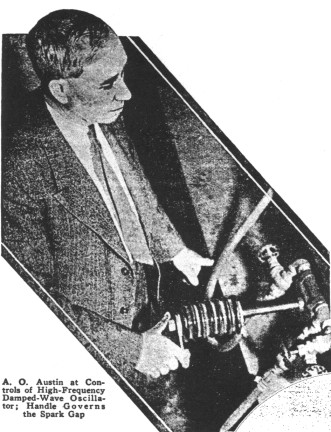
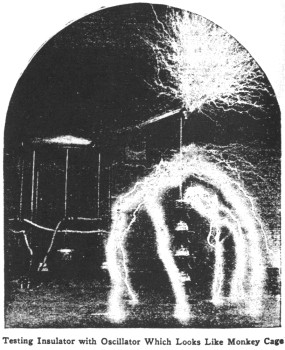
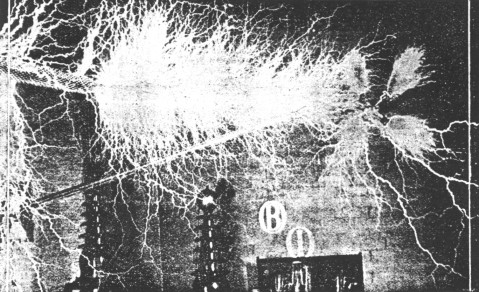
Large Image (144 Kb)
A Sample Transmission Line Being Subjected to High-Frequency Discharges; the
Experiment
Clearly Proves That Air Is a Poor Insulator at High Voltages and Frequencies
But why
employ equipment worth a small fortune to light a cigarette? The answer is
that the oscillator, although capable of performing tricks of magic that would
put Aladdin's lamp to shame, was not built for the purpose of igniting tobacco.
Its job at the high-tension laboratories of the Ohio Insulator company division
of the Ohio Brass company, at Barberton, is to help develop better insulators
so that you may enjoy more perfect radio reception, or read the evening paper
without fear that your electric lamp will fail.
Of all the expected and
unexpected tricks that electricity in its numerous forms can play, none are more
strange or spectacular than those which take place when the kilocycles dance at
Barberton. A. O. Austin, an authority on high-voltage work and insulation, is
the engineer who created the laboratory. He has gathered together as strange a
collection of giant transformers, huge spark gaps, generators, oscillators, and
various other machines and gadgets, as can be found anywhere on this earth.
"I'll show you what happens to an electric power line when lightning
strikes it," Austin announces.
He connects the high-frequency coil terminal
to a copper cable about forty feet long, suspended high above the floor by
porcelain insulators. Then he turns on a blast of air that makes a deafening
noise, rendering conversation impossible. The purpose of this air blast is not,
as one might at first suspect, to frighten spectators who already are nervous
over what is about to happen; it is used merely to cool the rotary spark gap
across which high-voltage current leaps to the oscillator coil.
The operator
throws a switch. Within a few seconds the fingers of flame start to grow and
dance all along the transmission line. They extend rapidly into streamers
several feet in length, and the crackling noise of these is heard above the roar
of the air across the gap. Oriental dragons which go about breathing fire and
exhibiting tongues of flame are mere mud puppies when compared with this
modern electrical monster which has the very ordinary job of helping make
insulators better.
The high-frequency discharge results in an odor of ozone,
created when the sparks knock oxygen molecules to atoms which then combine in a
different way. Nitrogen molecules also have been broken down, and the resulting
compounds are of an irritating nature. Often, when tests are run for
considerable periods in a closed room, breathing becomes difficult. This power
to convert oxygen into ozone, and nitrogen and other atmospheric materials into
various compounds, including nitric acid, is one of the most interesting things
associated with high-frequency currents. It suggests a spectacular method of
producing commercial fertilizers, although Mother Nature leads the field now
by making countless thousands of tons of such materials each year with
lightning.
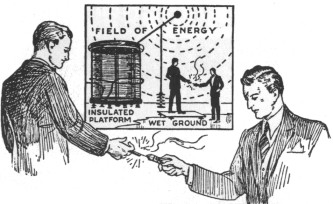
Using Continuous-Wave Oscillator to Light a Cigarette
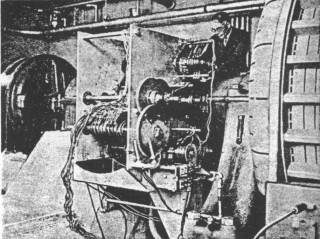
A Synchronous Switch with the Generator and Motor
More common than the commercial changing of gases is the use of high-frequency currents for melting metals and other substances. Everyone is familiar
with the high-frequency furnace which is really a step-down transformer whose
primary is fed by high-voltage, high-frequency electricity and whose secondary
is the mass of metal or the metal crucible to be heated. Suppose a few pounds of
nails are put into such a furnace. Eddy currents set up in the nails cause tiny
arcs between the pieces which quickly weld them into one piece. Further heating
melts the nails. One type of high-frequency furnace is used for driving gases
from the interior of radio tubes by bringing the metal plates and grids and
other parts to a high heat without heating the glass.
Austin was asked if he
could set up an electric furnace and operate it with his high-frequency
equipment.
"I've already got one," he laughed. "Put a man inside
that coil" -- he indicated the one that looks like a monkey cage--"and
he would run a fever from the eddy currents generated in his body. Or wrap a few
turns of wire around him, and he could be cooked in no time. Metal, of course,
is readily heated and melted in the same way."
There are dozens of other
tricks that can be performed with currents which oscillate a thousand times more
rapidly than the sixty-cycle variety which illuminates your home. A
High-frequency oscillator can be employed for welding metal parts together. A
special type has been designed for igniting gases in internal-combustion
engines. Sterilization of foods and various other materials has been found
possible. Experiments are being conducted in the killing of insects in grain
with high-frequency radiation. An oscillator can be used to punch holes in
insulating materials such as glass; in fact, that is the way it often behaves in
testing insulators.
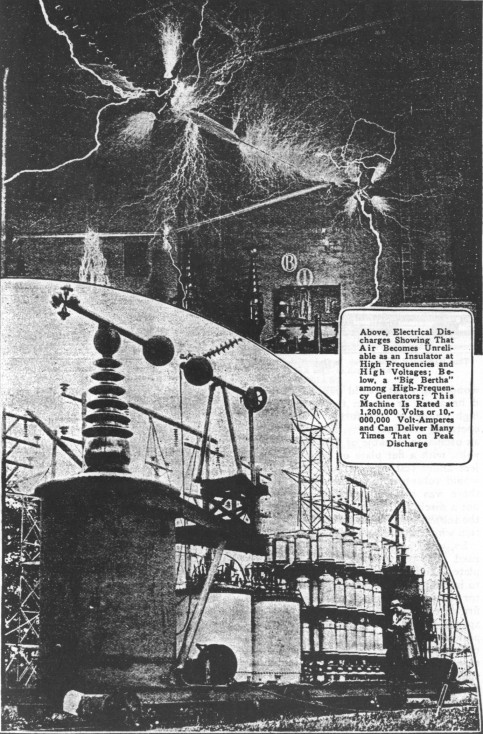
Large Image (294 Kb)
Once a group of experimenters got to wondering what would
happen to a man if he stood or sat on the terminal of a high frequency
transformer while it was operating at full capacity. So they equipped an
oscillator, capable of delivering 500,000 volts, with a flat plate on which the
subject under test could stand. But no one would volunteer to be the victim
because there was some uncertainty whether or not a discharge might take place
between the subject and some near-by point, an action which would be extremely
dangerous.
So, small animals, such as rabbits, were used. The test animal was
placed on the plate, which was sprinkled with salt water to insure perfect
contact, and the oscillator turned on gently. Crackling fingers of fire darted
out from the plate edges, and sparks leaped out from the nose, ears, points
above the eyes and other parts of the subject's body. When full power was turned
on, the length and intensity of the sparks increased. And when it was all over,
the subject hopped away unhurt.
Such electric baths are said to be invigorating,
and to act as a cleanser, dead skin particles and loose dirt being thrown off
with the discharges.
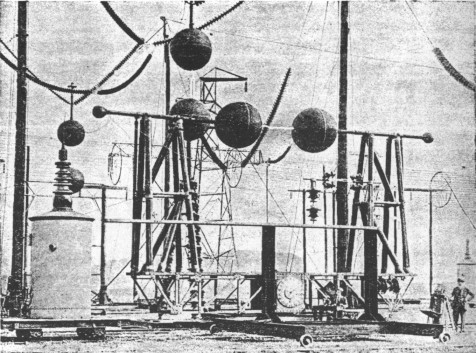
Large Image (153 Kb)
There seems to be considerable rivalry at the Barberton
laboratory between the oscillators and the "impact division," as to
which can put on the better show. Impact discharges are single, powerful strokes
of artificial lightning. They have on their side much of the massive equipment
at the laboratory -- a trio of transformers that tower more than two stories; a
collection of huge spheres made of pure copper; a long, cage-like arrangement
that forms one plate of an electrostatic air condenser; strings of insulators
looking like beads from the neck of a giantess, and countless other objects that
make a visitor suspect he may be on some other planet.
In operation, the
transformer trio generates high-voltage currents and feeds them to the cage that
forms one plate of the condenser, the other being the earth. When the cage has
been fed all the charge it can hold, a process requiring between seven and eight
seconds, the charge leaps to earth, or to the nearest grounded object, in a
brilliant flash that makes a noise like a high-powered rifle shot. This arc may
have a peak voltage of 3,500,000 and an amperage of 100,000 or more. Seldom more
that 1,500,000 to 2,000,000 volts are employed for routine testing. It
represents the nearest approach to natural lightning that electrical wizards
have been able to make. Its practical applications include the testing of
insulators, power-line towers, wood poles and other equipment.
Impact discharges
which, in some respects, resemble natural lightning more nearly than those
produced by the high-frequency oscillator, occur at the relatively low
frequency of sixty cycles -- the same frequency as your house-lighting circuit.
They represent tremendous force, and can explode fabric or wood, turning the
material into gases; rip strips from wooden poles; fuse wires; split insulators,
and duplicate other tricks of natural lightning.
The preceding article, Wonders
of Manmade Lightning, was sent in to us by Duane Zimmerman. It is reprinted from
Popular Mechanics, February 1933. © The Hearst Corporation. All Rights Reserved.
| 

































































